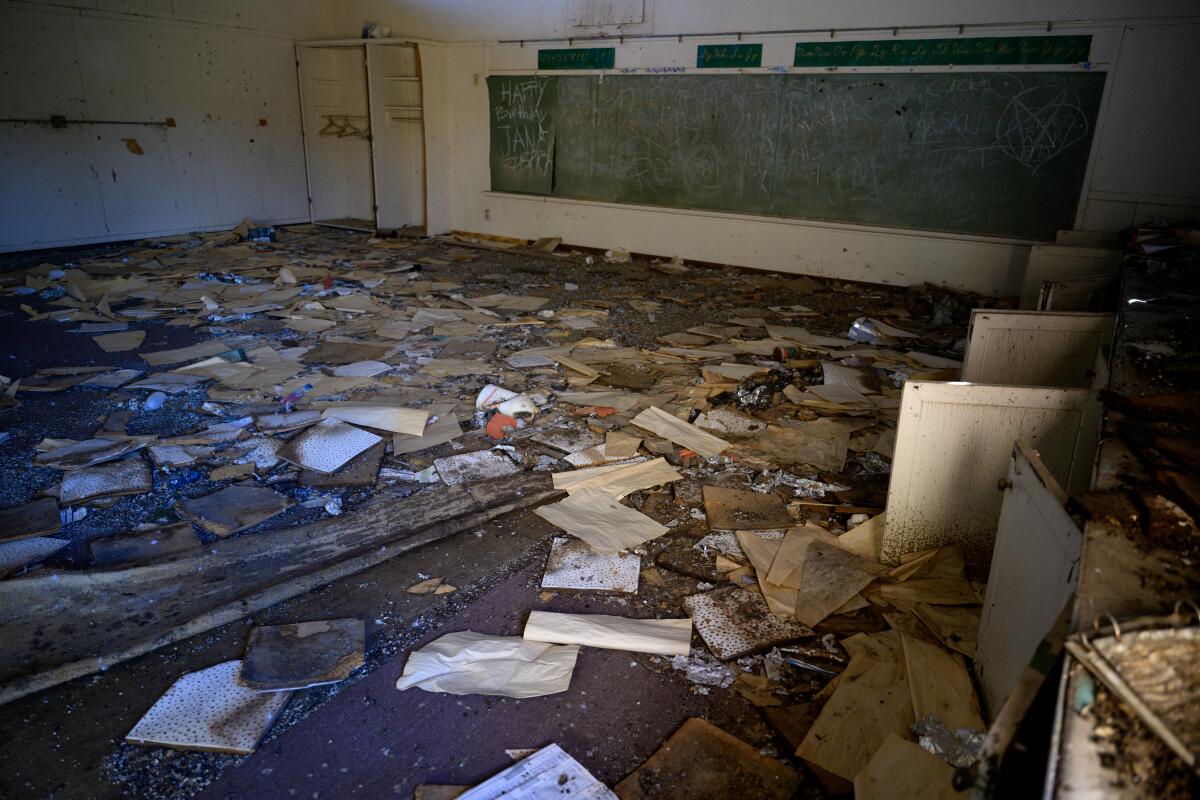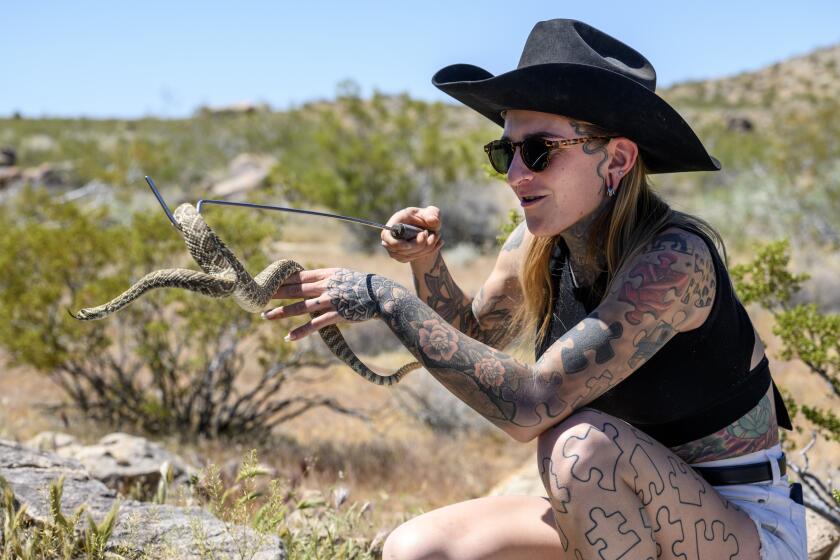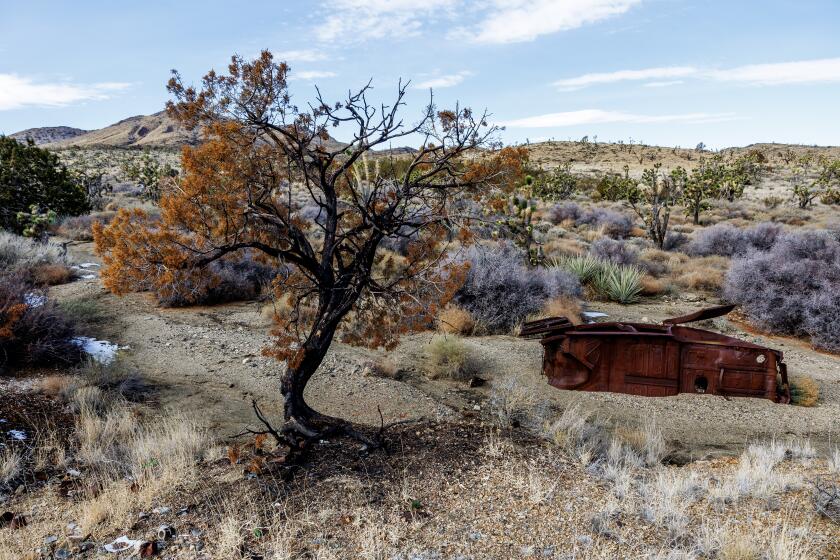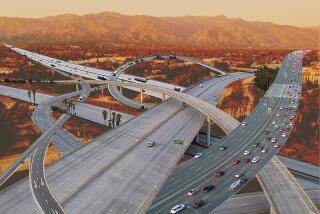
- Share via
AMBOY, Calif. — It’s a Friday afternoon in mid-May and a Czech biker is eating an ice cream cone at the counter of a gas station along a desolate stretch of the Mojave Desert. Outside, his entourage crowds around a towering Atomic Age sign for a group photo before speeding away along Route 66.
A British couple sip hot tea, though the mercury is pushing 100 degrees. A young woman in a crop top sits cross-legged in the middle of the street while a man films her, seemingly oblivious to the traffic whizzing by. On some days, small planes land on the dirt airstrip so their occupants can grab a root beer float or chili dog.
“It’s in the middle of nowhere in the desert, but you see a multitude of different types of people in Amboy,” said Kyle Okura, 31, who owns Roy’s gas station, along with the rest of the ghost town, after inheriting it from his father last year. “That’s what’s so amazing. You hear stories from all different parts of the world.”
Amboy has long served weary travelers — first as a railroad station, and later as a roadside attraction that’s especially popular with people touring the Mother Road, Route 66. But this slice of Americana has been beset by a series of crises that stretch back more than half a century. Most recently, heavy rains forced road closures that cut off traffic for weeks at a time, while international tourism faltered during the COVID-19 pandemic and has yet to recover.
Still, Okura thinks he can turn it around. No less than his father’s legacy is resting on it.
1

2

3

1. Inside the abandoned Amboy school. 2. From inside, playground equipment is still visible in a desolate schoolyard. 3. No children have passed under the now-faded sign since the school closed in 1999.
Settled as a mining camp in 1858, Amboy got its name 25 years later as an Atlantic and Pacific Railroad station — followed by Bolo, Cadiz, Danby, Essex, Fenner, Goffs, Homer, Ibis and Java, in alphabetical order to make them easier to remember.
Smack in the middle of a windswept corner of the Mojave that looks like Mars, its permanent population is now zero. Its infrastructure: a smattering of vacant houses and empty outbuildings; a shuttered post office, a church with no congregants and a school with no students. Visitors can climb an extinct cinder cone volcano nearby, although they’re warned to watch out for rattlesnakes and unexploded military ordnance.

Aside from a couple of salt mines just outside town, Roy’s is the only operational business. And the only operational portion of that is the store, stocked with cold drinks, snacks and souvenirs, and the gas station — three mechanical pumps that require an attendant to dispense fuel, which was recently priced at $6.49 for a gallon of regular.
But for Jan Kuzelka, a travel guide who’s been leading tourists from the Czech Republic and Slovakia on national parks sojourns for 12 years, Roy’s is an attraction that’s right up there with the Grand Canyon and Yosemite.
Its 50-foot neon sign has become a vaunted symbol of historic Route 66; its angular standalone lobby a marvel of Googie architecture.
“You sink into the ’60s here,” says Kuzelka, 49, as he stops in for a chat halfway through a daily itinerary that started in Joshua Tree and is set to end in Arizona. “It’s like a live museum.”
Within the space of a few hours, customers come in from Brazil, Belgium, Canada and France. The landmark seems to be most popular among Germans, says assistant manager Nicole Rachel, 48, as she stands behind the store’s chrome-trimmed counter while doo-wop blares from the speakers.

“They are very much into the Americana — the Route 66, the old diners,” she says. “They come through and they look and are like, ‘What are those?’ And I’m like, ‘They’re hot dogs.’”
A motorcycle tour group purchases five gallons of diesel. Upon learning they’re from Poland, manager Ken Large whips out his phone and plays a music video by Daria Zawiałow. The tourists gasp in delight when the pop star emerges from one of Roy’s vacant cabins, tousling her hair against the backdrop of the wrinkled mountains.
The joy is infectious, says Large, 49, a former flooring contractor who grew up in nearby Twentynine Palms.
“They all paid a huge amount of money to come from the other side of the planet and see what they think is the main part of America — it’s pretty cool.”
He glances out the window at a woman squatting in the middle of Route 66, hands outstretched to form a heart. “But when they don’t get out of the road, it’s kind of scary.”

Amboy has always been able to trace its ups and downs to the roads that run through it.
After Route 66 was paved in the 1920s, it became a lively boomtown with a couple of hundred residents. Roy Crowl opened a service station to cater to motorists traveling what was then the nation’s primary east-west artery. He was soon joined by his son-in-law, Buster Burris. Together they expanded Roy’s to include a cafe so they could feed waiting customers, and then a motel so they could house them overnight.
But in 1972, the construction of Interstate 40 about 10 miles north routed nearly all traffic away from Amboy, driving a stake through the heart of the enterprise.
The ghost town was in disrepair when Okura’s father — Albert “the Chicken Man” Okura, founder of the Juan Pollo restaurant chain — purchased it nearly 20 years ago from Burris’ widow for $425,000 and a promise to restore it. He quickly got to work, reopening the gas station and restoring the lobby, which now resembles a midcentury time capsule.
But recently, the roads have been giving Amboy trouble again.
Danielle Wall has transformed how locals interact with rattlesnakes. Her work has earned her a front-row seat to reshaping of California’s High Desert.
A string of intense storms, including Tropical Storm Hilary, unleashed flash floods over the past two years. The rains damaged aging timber bridges, crumbled roads and prompted people to rethink trips and end vacations early.
Outside of tourism, Amboy gets the bulk of its business from people who stop at Roy’s to buy a drink or use the bathrooms as they travel between California and Nevada or Arizona. The main road connecting Amboy to Interstate 40 was shut down for about a month earlier this year, “which completely destroyed our business” by decimating that traffic, Okura said.
A portion of Route 66 just east of Amboy has been closed for repairs even longer, since 2017, requiring tourists heading west to detour off the historic road and then travel back in order to visit the town.
Along that stretch, 69 timber bridges need to be replaced with concrete ones that appear historically accurate but are more structurally sound, said Amy Ledbetter of San Bernardino County Public Works. The work is expected to start at the end of this year with the replacement of two bridges, followed by 10 next year and 26 in 2027, Ledbetter said. Each bridge will cost about $3 million to replace, depending on its length, she said.
Amboy already is in a tough spot because it’s toward the end of the road for many Route 66 tourists, and in the midst of a long expanse of desert with few amenities, said Teresa Stamoulis, marketing director of the California Historic Route 66 Assn.
She estimates that 95% of travelers depart from the historic highway after they reach Needles, heading north to Las Vegas and over to the Grand Canyon. They then face a choice: travel back and finish Route 66 through miles of desert, detouring around the closure. Or take major interstates to its terminus in Santa Monica and consider the journey complete.

“That’s one of the challenges that we have, is really trying to convince people that the experience in our state is so different and so diverse, through the topography, through the people, through the communities,” Stamoulis said. The group in 2021 successfully lobbied for Route 66 between Needles and Barstow to be named a National Scenic Byway in the hopes of raising its profile, she said.
And while international tourists continue to make up a chunk of Amboy’s visitors, the big bus groups aren’t coming like they used to, Okura said. Before the pandemic, 10 to 12 would roll through each week; now, it’s roughly half that, he said.
Elijah Bowles picked up a package at the Twentynine Palms Post Office and found a live rattlesnake inside. An investigation is underway.
Okura can still recall the confusion he felt as a 12-year-old when his father announced his plans to purchase Amboy.
His dad had already bought the San Bernardino storefront on Route 66 that was the site of the original McDonald’s and opened a museum dedicated to the burger chain there. He similarly believed Amboy would attract publicity to his restaurant chain and bring him prestige, Okura said.
Still, when he first visited Amboy with his father later that year, he wasn’t so sure.
“All I could think was, ‘Man, this place is so far away. Where are we even going?’”
And then, when they got there: “Just a bunch of empty buildings.”

But over the years, Okura gradually took on a more active role. Each crisis and celebration was a way to bond with his father, who had worked every day for some 40 years — through holidays, his birthdays and his children’s birthdays. Employees recall him as an unassuming mogul who was often the first to arrive and the last to leave — in an old Subaru, even though he could have driven just about any car he wanted.
Okura traces the start of Amboy’s latest turnaround to 2019, when they relighted the sign after repainting it and restoring its neon tubes. About 80 aircraft flew in for the ceremony, some camping out overnight in what he described as “the most awesome scene ever.”
He noted the town isn’t permitted to promote the airstrip — it’s located primarily on Bureau of Land Management land and unsanctioned by the Federal Aviation Administration — but planes still show up.
Okura’s father never got to see his vision fully take shape. Last year, he became ill with what he thought was a stomach bug. By the time he sought care at a hospital, he had contracted sepsis. He died four days later at 71.
“I thought I was going to be working with him forever,” Okura said, noting that Albert Okura had regularly brought his own dad to work until just a month before his 100th birthday. “I thought we would be the same, we’d be working together until he was 100.”
Okura is in talks to have a portion of National Trails Highway, as Route 66 is now officially known, renamed Albert Okura Memorial Highway and hopes to eventually hang plaques around Amboy detailing his father’s quest to save it. But the best way to honor his dad is to push forward with the renovations and try to fulfill his vision, he said.
Last year’s York fire has sparked discussion about how to deal with conflagrations in the Mojave National Preserve.
Okura, who also became president of Juan Pollo, has a tiny but dedicated team in place to help tackle the next phase of Amboy’s resurgence, which he hopes will culminate in reopening the motel cottages and cafe.
Large, a history buff who oversees daily operations, ends up doing all manner of tasks, fixing water heaters and hauling supplies. The avid stamp collector hopes to someday reopen the Amboy Post Office: Its cancellation is one of the rarest in the United States.

Rachel, who formerly worked in child care and has always been drawn to the strange and surreal, handles the town’s social media accounts, advertising and filming logistics. In between manning the cash register and pumping gas, she also serves as a sort of cruise director for the Amboy experience, keeping the good times going by advising people where to pose to get the best picture or encouraging them to hose each other down with squirt guns from a kiddie pool of ice water.
Okura is replacing the septic system so he can reopen the public restrooms and get rid of the portable toilets that become pungent in 120-degree heat. He is installing gas generators to serve as a buffer against wind-driven power outages that can last for days, and running new gas lines to the property’s motel cottages, which he hopes to eventually list on a short-term rental platform.
The biggest challenge has been getting the supply of potable water needed to open the cafe. The property’s well water is reportedly 10 times as salty as the ocean, as the nearby mines would suggest, making it difficult to keep a reverse osmosis filtration system up and running. Okura is now working on a plan to have water hauled in.
His goal is to have much of this work done by the 100-year anniversary of Route 66 in 2026. Tourism officials hope the centennial will be a boon for businesses along the historic road.
Perhaps just as important to ensuring Amboy’s survival is marketing it to a younger generation beyond the Route 66 die-hards, Okura said.
The town is nothing if not photogenic, so social media has been a boon, he said. A search on just about any platform reveals a parade of images of women in cutoffs leaning on an antique car beneath the Roy’s sign or straddling the Route 66 shield printed on the asphalt; souped-up off-road vehicles lined up at the old-school gas pumps; roads that stretch out toward pale purple mountains in the distance.
1

2

3

1. Emily and Joe Coombs of Montana get an exclusive look inside the small historic church in Amboy. The Coombses spend their winters in Palm Springs and always stop for a root beer at Roy’s on the drive back to Montana. 2. Nicole Rachel stands in the doorway of the church, showing tourists the historic building. 3. Nicole Rachel unlocks the church for tourists.
The team has also continued a long tradition of renting Amboy for film and commercial shoots. While the town has served as the backdrop for many a slasher flick — “I don’t think we’ve had any romantic comedies,” Rachel said — some of the recent shoots have leaned higher-end. Roy’s appeared on the cover of Louis Vuitton’s Route 66 Travel Book a few years ago. Olivia Rodrigo filmed a portion of her music documentary “Driving Home 2 U” there. David Yarrow did a photo shoot with Cindy Crawford and a $7-million 1953 Ferrari Spider.
“One of the best memories I have is being out here at sunset with Cindy Crawford,” Large said. “I’m old. That might be as good as it gets for me.”
Okura credits this diversification with helping Amboy inch toward profitability — or at least sustainability. His dad used to subsidize operations with his own money. But last year, their books were in the black for the first time since he purchased the town, his son said.
And although Okura once saw only salt, sand and empty buildings, he now views the town through his father’s eyes, as a place that’s worth saving. A place that’s possible only in America, only on Route 66, only in this corner of the Mojave Desert.
“It’s unlike any other place you can visit,” he said. “There’s nothing like it and no way you can replicate something like Amboy.”
Destiny was his father’s favorite word and, in many ways, the organizing principle of his life — so much so that Okura plans on giving that name to his daughter, should he have one.
“When Amboy came along, he kept telling himself, ‘It is my destiny,’” he said. “So I do believe that now, moving forward, it’s part of my destiny to honor that.”

More to Read
Sign up for Essential California
The most important California stories and recommendations in your inbox every morning.
You may occasionally receive promotional content from the Los Angeles Times.















